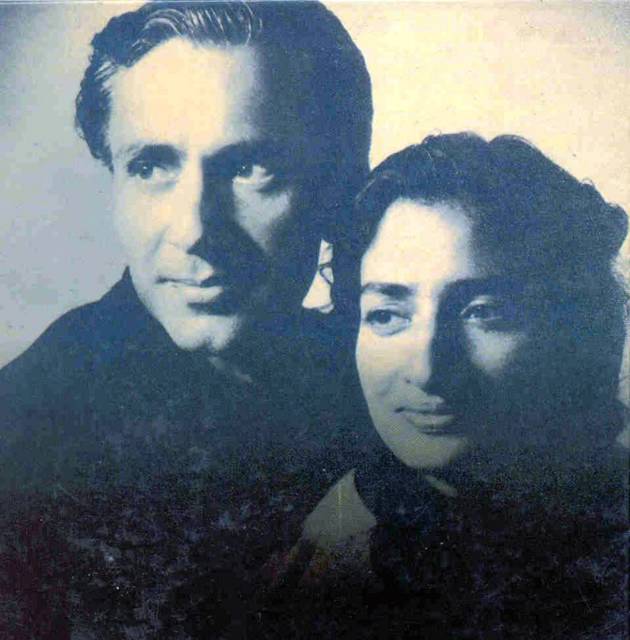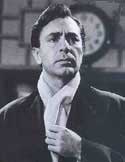Chapter II
I just spent a couple of hours with Mrs. Balraj Sahni this morning. I had coffee, not tea. And it was lovely.
She graciously let me borrow a book she had written, her autobiography, ‘Meri Sahit Sangeet Yatra', published this year. Although I will not be able to read it as it is in Punjabi, I wanted to scan and upload the stunning B&W portrait on the back cover, so I could include it in this post.
So I came away from her house, clutching both book and the realization that I had fallen hopelessly in love with her husband.
What happened earlier?
 The old green bungalow at the end of my road is half hidden from view because of the trees and huge clumps of bougainvillea climbing up its walls and exploding down its sides. This corner is called ‘Balraj Sahni Marg’.
The old green bungalow at the end of my road is half hidden from view because of the trees and huge clumps of bougainvillea climbing up its walls and exploding down its sides. This corner is called ‘Balraj Sahni Marg’.
As I swing open the gate of the house, and walk down the paved driveway and up to the front door, I realize the house is much larger than I thought. Large and rambling. I look up. Every window on the upper floor is tightly shut and the terrace looks bare. To my right is a large garage, but there are no cars here. As if to disturb the silence, a cat emerges from the thick overgrown shrubbery in the untended garden on my left and runs across my path. It is not black.
A maid sweeps the steps in front of the entrance, and smilingly asks me to enter. Although the door is ajar, I ring the bell politely and wait.
A voice emerges from the depths of the house. It says, “Unhey bithado, main abhi aa rahi hoon”.
I walk down a short broad passage and into the living room on the left. It is huge. This is a house that was probably built in the ‘50s. There are clusters of seating arrangements all over the room. All the furniture is art deco and well-worn. Large French windows lead to the garden. Everywhere, but everywhere, are trophies and framed certificates. On small tables, on cabinets, on shelves. I recognize a Filmfare statuette. There are small throw rugs, and in the middle of the room is a large sheet covering something on the ground. I learn later that it is a tanpura. An old violin case rests on a small sofa. I also learn later that Mrs. Sahni plays the tanpura [‘Whenever I am distressed, I need to find my own ‘sur’, and I play the tanpura. It puts me back in tune with myself’], the violin and the piano. A huge B&W portrait of Balraj saab shaking hands with Mrs. Gandhi dominates the space.
Time has been trapped in this room.
Mrs. Sahni enters silently and greets me warmly. She is happy to see me. She invites me to sit in a cozy corner and then immediately tells me that coffee is ready, and to make myself comfortable, and how much sugar would I want?
None, please, I say, and she leaves me with a pile of books. I am rummaging through them when she returns with a tray full of coffee and cream-centered biscuits held in her hands. She is the perfect hostess. Warm, caring, concerned.
When she had mentioned earlier to me that she was a writer, I must confess I did not take it seriously. So I am pleasantly surprised when she tells me all the books I was rummaging through are written by her. She shows me book after book, sheet after sheet that she had written in English, Punjabi, and Hindi. Children’s books. Short stories. Poems, plays. A screenplay. Some articles. Mrs. Sahni was also fluent in Russian and French at one time, but ‘just a smattering now, I have not been in touch’ she says with a little laugh. She is a little disappointed that I cannot speak or read Hindi too well, but all the same, I assure her I will attempt to read some of her writing. She gives me the hard copy of a book she spent one year writing, and then another writing the screenplay for the film. The title is, ‘Vasant Aisey Bhi Aaya’. She is currently looking for a producer who will be interested in her script.
“I was told by some what kind of screenplay to write. Boy meets girl, boy loses girl, boy again meets girl. Then they told me to add some rape scenes, but I refused. I will not write such scripts. I have not gone through my whole life to compromise on my principles. Writers, you know”, she added as she sipped her coffee, “… bhookey mar jaatey hai. I have struggled so much, and I am still struggling. But I am happy to know I have the capacity to struggle!”
Her first name is Santosh, she is Balraj saab’s second wife, and I am her newest friend. The elegant lady sitting in front of me in a crisp khaki-coloured cotton sari with a fine maroon all-over print, her thick silver hair worn in a loose braid is now probably in her 80’s, but time has not erased her beauty, nor dampened her spirit.
And as she starts talking about herself, about her life in England when she was working for BBC and living alone there before she got married, how she chose to be with Balraj saab because he was so ‘versatile’, and how they were equals and had mutual respect for each other’s qualities and talents, I know this, our first meeting, is just the tip of the iceberg of a long and happy friendship.
I thought I was a contemporary person, but here is someone who has been born far ahead of her time.
 [On right, the cover of Mrs. Sahni's autobiography, ‘Meri Sahit Sangeet Yatra']
[On right, the cover of Mrs. Sahni's autobiography, ‘Meri Sahit Sangeet Yatra']
Here is a small excerpt from an article she gave me a hard copy of, titled, ‘Thank You For Your Experience!’:
“A mid December Mumbai dawn, gentle and cool!
The Arabian Sea was like a carefree, smiling Geon girl, wearing an ankle-length bluish silk gown adorned with crisp white frills.
Leisurely strolling along the edges, I watched the shallow, frothy waves, tease my feet, creep up playfully, on unsuspecting shore, thus causing the sea shells to spin and the tiny crabs to scramble out of their sea-logged homes in panic!”
(I have no idea what ‘Geon’ means. I will ask my friend, next time.)
More on Mrs. Santosh Sahni, later :)
Read more!
 Mr. Balraj Sahni was a legendary actor who won over the hearts of Indian viewers with his dignified, graceful and understated performances. He was a true professional and at ease with both art and commercial film.
Mr. Balraj Sahni was a legendary actor who won over the hearts of Indian viewers with his dignified, graceful and understated performances. He was a true professional and at ease with both art and commercial film.